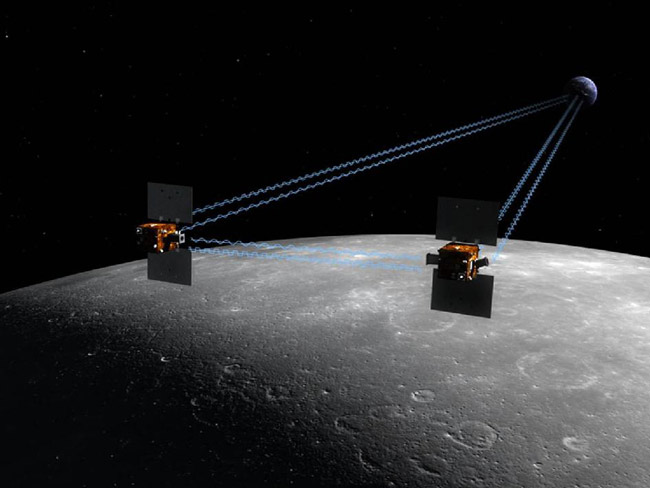Twin Moon-Mapping Space Probes Begin Extended Mission

A pair of robotic spacecraft in orbit around the moon began collecting data on lunar gravity again last week, as part of the probes' extended mission.
NASA's twin Grail spacecraft (short for Gravity Recovery and Interior Laboratory) are studying the lunar gravitational field in unprecedented detail to help astronomers better understand how the moon — and other rocky bodies in the solar system — formed and evolved.
On Aug. 30, the mission officially entered its extended science phase, when the Lunar Gravity Ranging System instruments were switched on aboard both probes. The milestone occurred as the two spacecraft were flying 19 miles (30 kilometers) above the moon's Ocean of Storms, NASA officials said.
The extended Grail mission will run until Dec. 3, and will make even closer and more detailed observations of the moon's gravity field.
During this time, the orbits of both spacecraft will be lowered by 50 percent to examine the gravitational influence of surface and subsurface features on the moon. In fact, the Grail probes will be flown at the lowest altitude that can be safely maintained, according to mission managers.
"The data collected during Grail's primary mission are currently being analyzed and hold the promise of producing a gravity field map of extraordinary quality and resolution," Maria Zuber, Grail principal investigator from the Massachusetts Institute of Technology in Cambridge, Mass., said in a statement. [Photos From NASA's Moon Gravity Mission]
Throughout Grail's prime mission, which lasted from March 1 to May 29, the two spacecraft flew an average of 34 miles (55 km) above the lunar surface. For the extended mission, the Grail probes, which are named Ebb and Flow, will orbit at an average altitude of 14 miles (23 km), which means they will pass within five miles (8 km) of some of the higher surface features on the moon, mission managers explained.
Get the Space.com Newsletter
Breaking space news, the latest updates on rocket launches, skywatching events and more!
"Mapping at a substantially lower altitude during the extended mission, and getting an even more intimate glimpse of our nearest celestial neighbor, provides the unique opportunity to globally map the shallow crust of a planetary body beyond Earth," Zuber added.
The Lunar Gravity Ranging System transmits radio signals between the two Grail spacecraft, measuring the precise rate of change in the distance between the washing machine-size probes as they chase each other around the moon.
As Ebb and Flow fly over areas of greater and lesser gravity, the distance between them changes. These gravitational disturbances may be caused by visible features on the moon, such as mountains, craters and other subsurface masses, mission managers said.
"Ebb and Flow, and our mission operations team, are both doing great, which is certainly notable considering all the milestones and challenges they have experienced," David Lehman, Grail project manager at NASA's Jet Propulsion Laboratory in Pasadena, Calif., said in a statement. "The twins have endured the lunar eclipse of June 4, 2012, and 26 rocket burns since arriving in lunar orbit at the beginning of the year. Down here in our control room, with all the planning and mission operations we have been doing, it feels as though we've been riding right along with them. Of course, they have the better view."
The $496 million Grail mission launched in September 2011, and the two spacecraft entered lunar orbit on New Year's Eve and New Years Day, respectively.

Follow SPACE.com on Twitter @Spacedotcom. We're also on Facebook and Google+.
Join our Space Forums to keep talking space on the latest missions, night sky and more! And if you have a news tip, correction or comment, let us know at: community@space.com.

Space.com is the premier source of space exploration, innovation and astronomy news, chronicling (and celebrating) humanity's ongoing expansion across the final frontier. Originally founded in 1999, Space.com is, and always has been, the passion of writers and editors who are space fans and also trained journalists. Our current news team consists of Editor-in-Chief Tariq Malik; Editor Hanneke Weitering, Senior Space Writer Mike Wall; Senior Writer Meghan Bartels; Senior Writer Chelsea Gohd, Senior Writer Tereza Pultarova and Staff Writer Alexander Cox, focusing on e-commerce. Senior Producer Steve Spaleta oversees our space videos, with Diana Whitcroft as our Social Media Editor.









